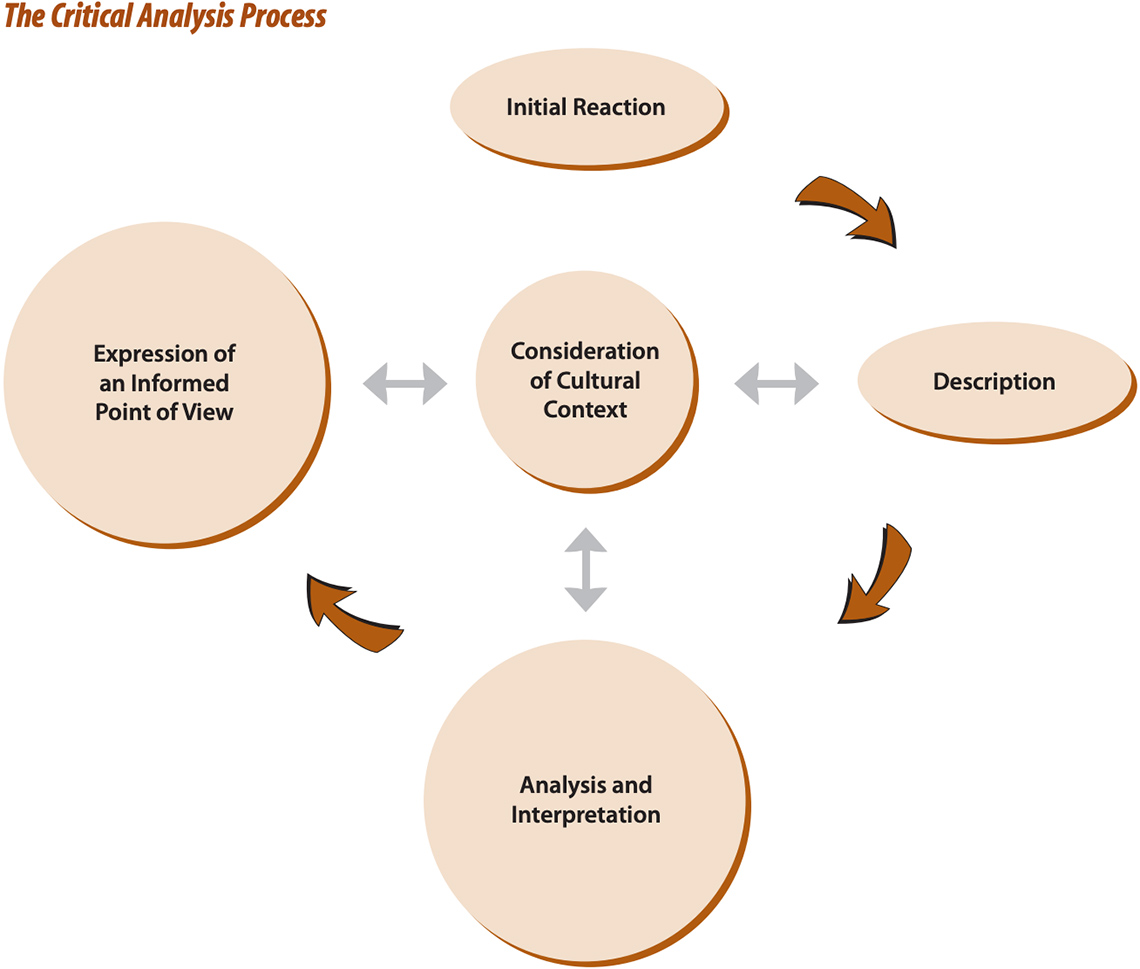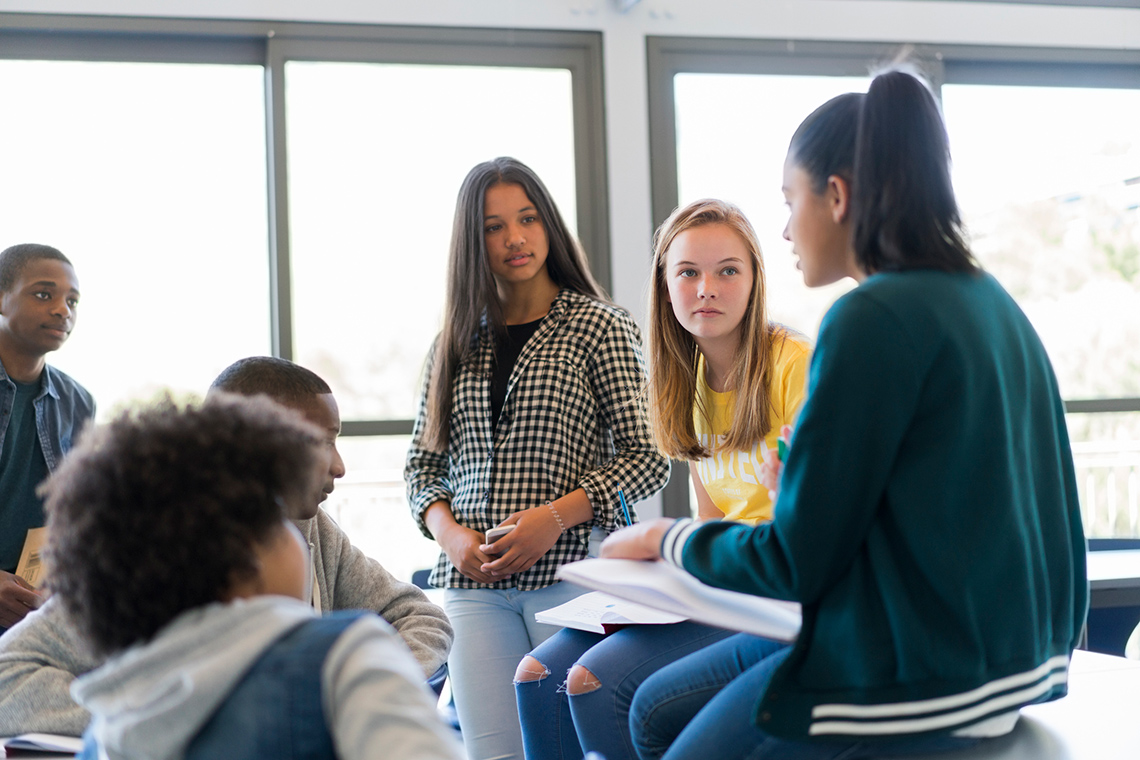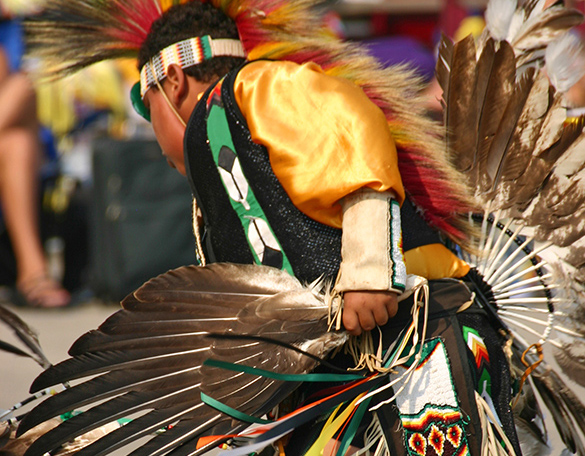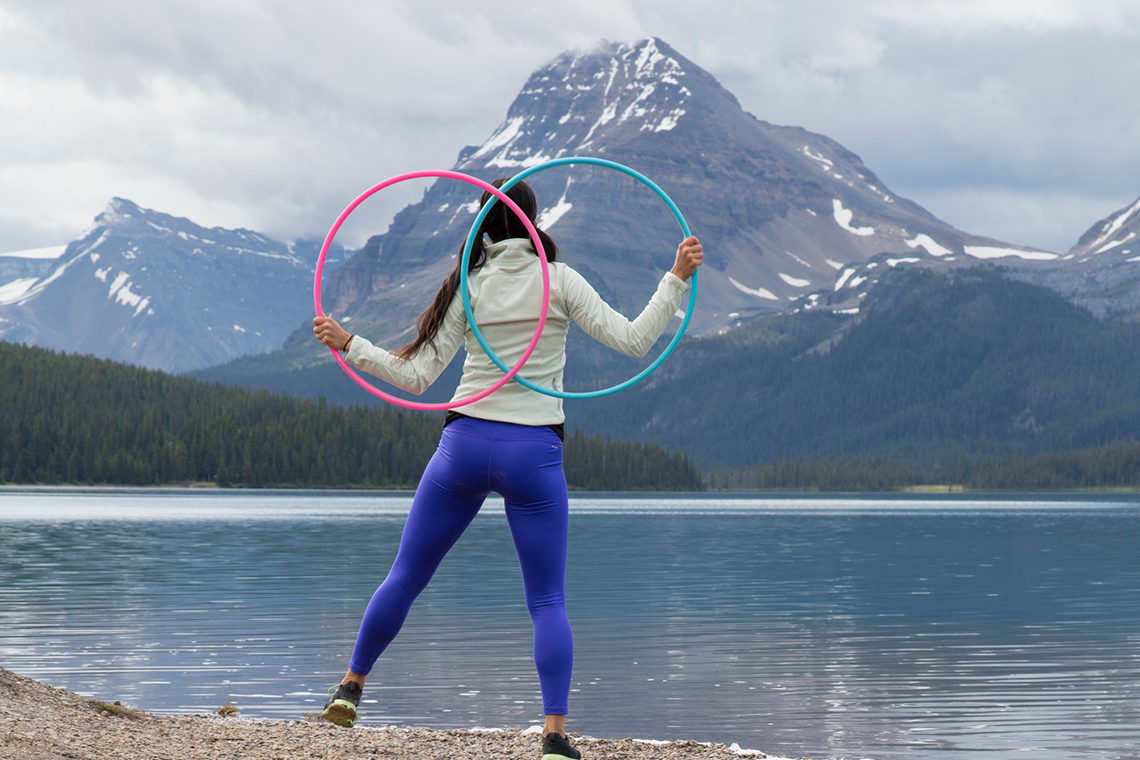Minds On
Let’s get started!
Press the following tabs to access today’s vocabulary.
Dance uses the elements of dance to communicate a meaning to the audience. The critical analysis process can help an audience unpack what a dance piece is about.

An illustration that explains the critical analysis process. There is a bubble labelled “Critical Analysis Process” in the middle of the illustration. Around the “Critical Analysis Process” bubble, there are 4 other bubbles. The first is “Initial Reaction” at the top followed by an arrow leading to the second bubble that is labelled “Description” on the right side. Then, there is an arrow leading to the bottom bubble that is labelled, “Analysis and Interpretation” and a last arrow leading to the bubble labelled, “Expression of an Informed Point of View”.
Let’s use the critical analysis process to explore an excerpt of the dance piece, Great Lakes, by the Indigenous dance company Red Sky.
Check out this video entitled ”Red Sky Performance: Great Lakes Excerpt” to learn more about how to analyze a dance piece.
Portfolio
Portfolio
Consider adding this Initial Reaction document to your portfolio.
Record your initial reaction to the piece. Complete the Initial Reaction in your notebook or using the following fillable and printable document. If you would like, you can use speech-to-text or audio recording tools to record your thoughts. Don’t analyze too much, just jot down your initial thoughts!
Consider adding your work to your dance portfolio.
| Initial Reaction | Your ideas... |
|---|---|
|
Respond to one or more of the following prompts:
|
Press the ‘Activity’ button to access Initial Reaction.
Action
Get ready, get set…
Task 1: Exploring the description phase
Revisit Red Sky’s dance piece.
Check out this video entitled “Red Sky Performance: Great Lakes Excerpt” to learn more about how to analyze a dance piece.
Portfolio
Portfolio
Consider adding this document to your portfolio.
Write down your ideas about the dance that you have just explored. Complete the Critical Analysis Process in your notebook or using the following fillable and printable document. If you would like, you can use speech-to-text or audio recording tools to record your thoughts. Fill in the “Your ideas” column only. Consider adding your work to your dance portfolio.
Press ‘Elements of Dance’ to access a chart with the different elements.
| Element of Dance | |
|---|---|
|
Body |
What is your body doing? Consider the following questions: What different body bases could you use to create a shape with your body? What different body parts could you move? How many different locomotor and non-locomotor movement could you create? Could you create symmetry in your body? What about asymmetry? What kinds of angular shapes could you make? What kind of curved shapes could you make? |
|
Space |
Where is your body moving? Consider the following questions: How could you move at a high, middle, or low level? What different pathways could you travel (in a straight line, in a zigzag, backwards)? If you are dancing with someone else, how is it different when you dance close together vs. far apart? |
|
Time |
When is the body moving? (in relation to time) Consider the following questions: How could you move at various speeds (e.g., fast, medium, slow)? How it is different dancing to music vs. dancing without music? Could you add a pause or a moment of stillness into your movements? |
|
Energy |
How is the body moving? Consider the following questions: How could you move lightly (e.g., as if you are a balloon floating through the sky, as if you are an astronaut in outer space? How could you move as if your body was heavy (e.g., as if you were pushing a big piece of furniture across the floor, as if you were moving through thick mud)? What is an example of a sudden movement? What is an example of a sustained movement? |
|
Relationship |
Who or what is the body moving with? Consider the following questions: How might dancers meet or part in a dance piece? How could emotions or facial expressions be added to movements? How could you move around, under, or over a prop? |
| Phase of the Critical Analysis Process... | Your ideas... | New thoughts... |
|---|---|---|
|
Description Respond to one or more of the following prompts:
|
Press the ‘Activity’ button to access Critical Analysis Process.
Task 2: Considering the cultural context in the arts

A part of growing up and learning is developing a better sense of how to interpret and understand the world around you. Cross-cultural understanding describes the level of awareness and understanding that people from different cultural backgrounds can have for cultures outside of their own. In art, as well as in life, it is important that all people learn about different cultures so that they can treat everyone in a respectful and kind way. Cultural differences not only make people unique, but also provide diverse perspectives and ideas, which makes communities better.

Artist and Shaman Between Two Worlds, Norval Morrisseau, 1980
Indigenous art forms are distinct from Canadian or Western art forms because the protocols, values, histories, and worldviews that are used to design and create a piece are quite different.
Indigenous art is based on cultural and community knowledges, teachings, and lived experiences. These forms of art have also been treated differently both in the past as well as in the present. Western perspectives were predominantly used to interpret all art forms throughout history. This meant that Indigenous art forms were not valued the same way and were thought of as inferior to western art. As a result, Indigenous art was not featured in mainstream art galleries or dance companies, and thus audiences did not develop a true understanding of Indigenous art forms, because they did not have the education to be able to fully appreciate it.
Today, there is an awareness of the history, and as a result more spaces are dedicated specifically to showcasing Indigenous arts. Students and audiences also have more education about Indigenous peoples and consider this when interpreting and analyzing the arts.
Building your cultural awareness and understanding can help you to appreciate Indigenous art and art forms including dance. It will help you dig deeper and ask questions you may not have thought of before when analyzing and interpreting the arts. You may think about whose story is missing? Or for who specifically is this piece created? Or how do we appreciate a piece on its own without applying “Western” cultural standards?
Indigenous arts and perspective

A dancer or choreographer’s life experiences and view of the world will inform how they create dance works. Considering the social, cultural, and historical context in which a work was created can help us understand its meaning.
For example, Red Sky is a contemporary Indigenous dance company that aims to “elevate Indigenous arts and culture in ways that celebrate, uplift, and respect Indigenous cultures”.
They often fuse cultural knowledge, practises, and dance through live music, theatre, and visual images in their performances.
The dance piece “Great Lakes” explores the connection between Indigenous peoples and “the five freshwater lakes, and to the life-sustaining and creative nature of water”.
Traditional territories are the places that Inuit and First Nations peoples occupied and called home before contact with Europeans. Métis peoples were born of the relationships between European and First Nations peoples, and thus we call their history before contact, pre-Métis history. These territories reach across Turtle Island and were the places where people hunted, fished, and raised their families. These lands have deep significance to Indigenous peoples.

The places in which a particular community lived have a great impact on how they would come to understand the world around them. From their languages to traditions to the stories that communities told as well as geography, all helped form specific community worldviews.
Each nation or community has their own laws or teachings regarding sustainability and how to care for the Earth. This knowledge comes from the long history of Indigenous peoples living on the land, with successive generations learning about the specific waters, lands, and ecological factors that exist within a given area. This is also why Indigenous art forms are so diverse and illustrate diverse ideas from different communities.
However, most if not all Indigenous communities believe that humans, fish, and animals are all equal and that the land and the water have a spirit that needs to be protected. Land and water in this sense cannot be owned, rather they are shared. These resources are also not to be used to excess. Rather, each person has a role and responsibility to take care of and preserve the waters for future generations.
Check one of the Indigenous chiefs’ first mandates
We are looking ahead, as is one of the first mandates given us as chiefs, to make sure and to make every decision that we make relate to the welfare and well-being of the seventh generation to come. What about the seventh generation? Where are you taking them? What will they have?
– Oren Lyons, Chief of the Onondaga Nation
Indigenous peoples have long understood the significance of protecting the earth. Many communities took the time to celebrate and give thanks for all that the Earth has given including the waters. These ceremonies acknowledge and give thanks for upcoming changes in weather patterns and harvesting activities. Giving thanks and honouring the relationships with Mother Earth and the waters remain an important part of Indigenous life today as many nations and communities still practise giving thanks regularly to the Creator or the Great Spirit and all of creation through prayer and as part of ceremony.
Go!
Task 3: Revisiting your initial ideas
Having information about the dance and examining the dancer and choreographer’s use of the elements of dance can help us interpret a dance piece. Having more information about a dance piece can help you expand on or revise your initial impressions. You might also start to make connections between the work and your own ideas and experiences. Examine your initial reaction. Has it changed? There is no one “right” way to interpret a dance piece, but start to think about how to support your thinking with examples and evidence from the work. Revisit Red Sky’s dance piece.
Access this video entitled Red Sky Performance: Great Lakes Excerpt to learn more about how to analyze a dance piece.
Portfolio
Portfolio
Complete the Critical Analysis Process in your notebook or using the following fillable and printable document. If you would like, you can use speech-to-text or audio recording tools to record your thoughts. Fill in the “New thoughts” column only. Consider adding your work to your dance portfolio.
| Phase of the Critical Analysis Process... | Your ideas... | New thoughts... |
|---|---|---|
|
Description Respond to one or more of the following prompts:
|
Press the ‘Activity’ button to access Critical Analysis Process.
Consolidation
Putting it all together

Use the following questions to reflect on your learning.
- Did you find the Critical Analysis Process a helpful framework to guide your thinking about the dance piece? Why or why not?
- Which phase(s) of the process did you find the most valuable? Why?
- Is there anything you think is missing from this process?
- How might you use this process to analyze your own dance pieces?
- Why is the cultural context phase so important?
- Compare the two columns of your graphic organizer. Did your ideas change or evolve as you learned more information about the dance piece? Explain your thinking.
Record your responses using a method of your choice.
Reflection
As you read through these descriptions, which sentence best describes how you are feeling about your understanding of this learning activity? Press the button that is beside this sentence.
I feel…
Now, record your ideas using a voice recorder, speech-to-text, or writing tool.